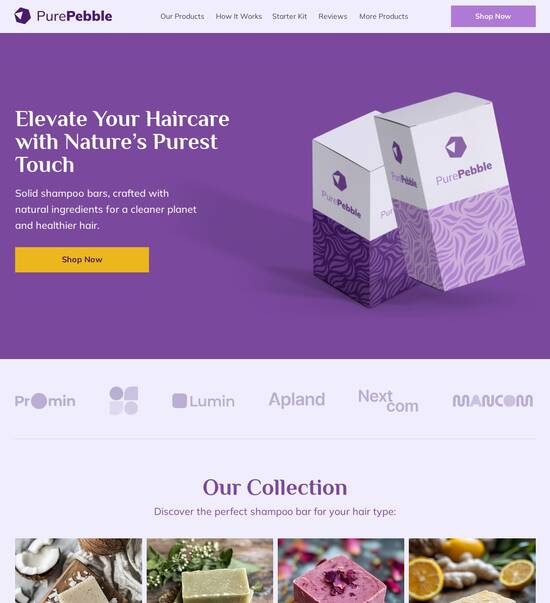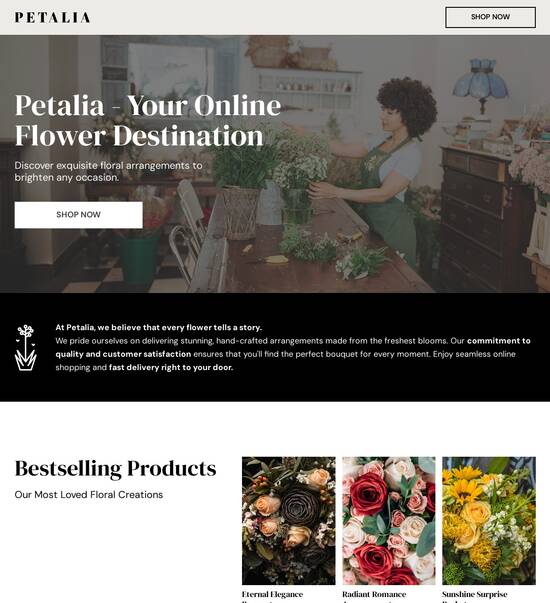
Laravel optimized product page templates
Explore Similar TemplatesAbout template
Make the most with Laravel optimized product page templates. Drive your success today.
Recommended templates

Easy to build without coding
With the intuitive drag-and-drop builder, anyone on your team can create high-converting pages without any knowledge of code or design. Make enhancements to your landing page with custom widgets using Javascript, HTML/CSS, or third-party scripts.

Multiple layouts for any industry and goal
Select from 500+ landing page layouts built to boost conversions across industry-specific scenarios. Customize them by adjusting fonts, adding images, and generating on-brand content with the AI assistant. Quickly scale with Instablocks® and Global Blocks that you can save, reuse, and update globally.

Loads fast and looks polished on any device
Every template is responsive, which means they present professionally on any device and load blazingly fast with our Thor Render Engine. You can also power them up with Google AMP technology to deliver an unparalleled mobile experience and drive higher conversions.

Robust analytics & experimentation
Get real-time updates and reporting across all your devices, showing the number of visitors, conversions, cost-per-visitor, and cost-per-lead. Launch AI-powered experiments, run A/B tests, and use heatmaps to analyze user behavior, then optimize your landing page to maximize conversions.







Easy to build without coding
With the intuitive drag-and-drop builder, anyone on your team can create high-converting pages without any knowledge of code or design. Make enhancements to your landing page with custom widgets using Javascript, HTML/CSS, or third-party scripts.
Multiple layouts for any industry and goal
Select from 500+ landing page layouts built to boost conversions across industry-specific scenarios. Customize them by adjusting fonts, adding images, and generating on-brand content with the AI assistant. Quickly scale with Instablocks® and Global Blocks that you can save, reuse, and update globally.
Loads fast and looks polished on any device
Every template is responsive, which means they present professionally on any device and load blazingly fast with our Thor Render Engine.
Robust analytics & experimentation
Get real-time updates and reporting across all your devices, showing the number of visitors, conversions, cost-per-visitor, and cost-per-lead. Launch AI-powered experiments, run A/B tests, and use heatmaps to analyze user behavior, then optimize your landing page to maximize conversions.
All the features you need to build laravel product designer tool
Explore more featuresLearn how to build laravel landing page template free
Frequently asked questions about laravel ecommerce project template free download
Leading the way in building high-performing landing pages





Laravel ecommerce templates: Your ultimate how-to guide
An optimized landing page is vital for enhancing conversions in digital marketing campaigns. Instapage's powerful platform provides marketers with the tools they need to create stunning, high-converting pages rapidly, improving marketing ROI significantly.
Understanding the Instapage advantage
Instapage offers a unique solution tailored for various industries such as tech, financial services, and education. Here’s why it stands out:
- 100+ high-converting templates: Utilize pre-designed templates that cater to diverse markets and objectives, significantly speeding up your campaign launch.
- Advanced optimization tools: Built-in A/B testing and heatmaps ensure your landing pages are continually optimized based on user behavior.
- Dynamic content personalization: Instapage lets you tailor your messaging to specific audience segments, ensuring maximum engagement.
Step 1: Creating your landing page
Begin by selecting a template that aligns with your campaign goals. Instapage offers a wide array of customizable options. After selecting your template, utilize the drag-and-drop builder to personalize it according to your brand's aesthetics.
Step 2: Optimizing for conversions
Once your page is created, it's crucial to optimize it for better performance. Consider the following steps:
- Implement A/B testing to evaluate different page versions and determine the most effective layout.
- Use heatmaps to analyze user interaction, adjusting elements based on where users are clicking the most.
- Incorporate lead generation forms strategically to maximize your lead capture rate.
Step 3: Analyzing performance
Use Instapage’s analytics dashboard to gain insights into your landing page's effectiveness. Key metrics to monitor include bounce rate, time on page, and goals completed.
- Track conversions and analyze which elements of your page performed well.
- Evaluate your traffic sources to understand where your visitors are coming from.
- Review audience engagement metrics to tailor future content more effectively.
In conclusion, leveraging Instapage for optimized landing pages not only enhances user experience but also drives higher conversion rates.
Ready to uplift your digital marketing efforts? Sign up for Instapage today and start transforming your campaigns into conversion powerhouses.
Laravel optimized product page template
Understanding the core of Laravel: Building an optimized product page template
Laravel is an open-source PHP framework preferred by many developers for building modern web applications. Its design is based on the MVC architectural pattern, which separates concerns between the data, user interface, and logic of the application. The scalability and robust features of Laravel make it especially beneficial for e-commerce applications, where efficient product page management is crucial for enhancing user experiences and driving sales.
Defining the Laravel framework and its benefits
Laravel provides a clean and elegant syntax that simplifies complex tasks. One of its most significant advantages is scalability; developers can extend the framework to build anything from simple websites to large-scale enterprise applications. When applied to e-commerce, Laravel facilitates a seamless product manager experience, allowing quick updates and flexible product page designs.
Moreover, key features such as built-in authentication, Eloquent ORM for database interactions, and routing are instrumental in optimizing product pages. With these tools, developers can construct tailored experiences for visitors while maintaining high-performance standards.
Project directory structure for product pages
Understanding the project directory structure is vital for maintaining an optimized product page. The primary directories include **app/Http/Controllers**, where routing and request management occurs; **resources/views**, for creating front-end templates; and **public/**, which manages all assets including CSS and JavaScript files. An organized directory promotes clarity in development and eases navigation through the codebase.
Each component of this structure plays a role in the overall functionality of the product page. For instance, the controller handles user requests, and the views display the product information in a user-friendly manner. This separation of concerns allows for easier management of business logic and presentation layer, enhancing the development experience.
Crafting the optimal product page experience
An efficient product page template must have essential elements that enhance user experience. Key elements include high-quality images, which are critical for giving a realistic view of the product, along with galleries to showcase multiple angles or variants. Clear and concise product descriptions help visitors understand the features and benefits without needing additional back-and-forth.
Pricing is another crucial aspect; displaying promotions or discounts clearly can encourage purchasing decisions. Therefore, achieving the right balance between aesthetic appeal and functionality is vital. Products should not only look good but also operate efficiently, providing users with a seamless purchasing journey.
Leveraging Laravel technologies for enhanced functionality
Using Laravel’s technologies can significantly enhance product page functionality. One powerful feature is Eloquent ORM, which offers a straightforward ActiveRecord implementation for interacting with the database. This means developers can easily manage product data while maintaining high performance and security standards.
Additionally, the Blade templating engine allows for dynamic content rendering while minimizing the amount of PHP code within the view. Laravel Mix, a tool for compiling assets, further optimizes page loading speeds by minifying and combining CSS and JS files, ultimately leading to an improved user experience.
Creating routes for seamless navigation
Defining web routes for product pages is an essential step for maintaining user-friendly navigation. Dynamic URLs can be set up uniquely for each product, promoting better SEO practices by making web addresses more readable. This is not only important for users but also helps search engines index products effectively, leading to improved visibility.
Define routes in the routes/web.php file for product pages.
Utilize route model binding in Laravel to retrieve product details based on the URL.
Make use of named routes for easier referencing throughout the application.
With a well-structured routing system, users can navigate the e-commerce site more fluidly, reducing frustration and bounce rates.
Dynamic content generation and management
To ensure product pages reflect current inventory and offerings, Laravel’s built-in validation tools help manage form inputs effectively. This means ensuring that user-generated content, such as product reviews and comments, adheres to specified standards, thereby preventing unwanted data issues.
Moreover, utilizing AJAX requests allows for dynamic content updates without needing to reload the entire page. This is particularly beneficial for product pages where users expect quick responses—such as when adding items to their cart or checking availability—leading to improved user satisfaction.
Managing dependencies and configurations
Handling package dependencies is simplified in Laravel through Composer. Developers can manage required packages and libraries efficiently, ensuring that your e-commerce application remains up to date with the latest features. Essential packages for enhancing e-commerce functionalities include tools for handling payments, integrating analytics, and managing API requests.
Setting up environment configurations is also key. Developers typically maintain separate configurations for local development and the production environment, ensuring that sensitive information remains secure while allowing for smooth transitions between hosting environments. Following best practices in dependency management can prevent a host of issues down the line.
Server configuration and optimization techniques
Choosing the right server setup for hosting Laravel applications is crucial for overall performance. Recommended setups include shared hosting for smaller applications or dedicated servers for larger e-commerce ventures. Using solutions like Nginx along with caching mechanisms such as Redis can help dramatically increase page load speeds.
Different caching strategies—such as query caching or page caching—enhance the performance of product pages by storing frequently accessed data and reducing database calls. Addressing server challenges proactively ensures that your e-commerce platform runs smoothly while providing a positive experience for users.
Preview and testing mechanisms for product pages
Creating testing environments for product page previews is essential for quality assurance. This allows developers to make changes and test them rigorously before deployment, minimizing disruptions to the live site. Employing Test-Driven Development (TDD) or Behavior-Driven Development (BDD) practices ensures that the product page meets specified requirements and is free from bugs.
Engaging users for feedback post-launch is also critical. Gathering user insights can drive iterative improvements, making sure the product page continues to meet user needs.
Engaging with developer communities for support
Being part of developer communities can be invaluable for Laravel developers. Platforms like Laracasts, Laravel.io, and Stack Overflow offer a wealth of knowledge. Developers can ask questions, share knowledge, and find solutions to common problems faced while developing product pages.
Crafting effective queries will help you get quicker and better responses. Offering context about your issue and what you have already attempted encourages constructive engagement. Sharing your experiences not only helps others but can also open avenues for collaborative work.
Collaborative work within development teams
Utilizing version control, particularly Git, is essential for collaboration within development teams. It allows multiple developers to work on the same project without conflicts, making it easy to track changes and revert if necessary. Establishing best practices for committing code changes can streamline workflows, allowing developers to focus on creating features rather than managing versions.
Employing platforms like GitHub or GitLab enhances collaboration through features such as issue tracking and pull requests, facilitating smoother communication within teams. These tools promote a robust development process, ensuring that teams meet deadlines while producing high-quality product pages.
Considerations for future enhancements
The landscape of e-commerce is perpetually evolving, and incorporating AI-driven recommendations can optimize product visibility on your pages. This feature enhances user experience by presenting tailored product suggestions based on user behavior and preferences.
Additionally, back-end integrations with third-party services such as payment processors or CRMs can enhance functionality. As real-time interactions become increasingly popular, exploring features using Laravel Echo will allow you to communicate via WebSockets, giving users a more interactive experience on product pages.
Exploring common questions about Laravel product pages
Developers often have questions about optimizing product pages with Laravel. Common challenges include dealing with load speeds and managing databases efficiently. Focusing on optimizing images and assets can lead to faster load times, while employing indexed databases can improve data retrieval speed.
Resources such as the Laravel documentation, Laravel News, and community forums serve as excellent support systems for developers looking to enhance their skills. Continuous learning via these platforms will promote a better understanding of Laravel and its capabilities within e-commerce.
Ready to skyrocket conversions?
Supercharge your ad campaigns with high-performing landing pages
Get started














